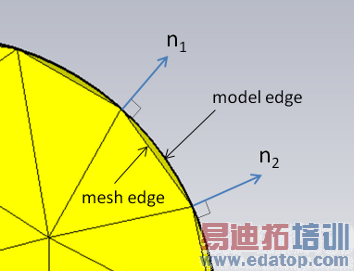- 易迪拓培训,专注于微波、射频、天线设计工程师的培养
CST2013: Special Mesh Properties - Mesh Control
 Simulation: Mesh
Simulation: Mesh  Global Properties [Specials...]
Global Properties [Specials...]  Mesh Control
Mesh Control
Smooth mesh with equilibrate ratio: This option controls the mesh smoothing in order to improve quality of the generated mesh. It represents the maximum ratio between the lengths of two adjacent edges. This parameter must be greater than 1. The more it is close to 1, the smoother the resulting mesh will be.
Mesh optimization: If this field is checked (recommended), the mesh connectivity of the surface mesh is changed to improve mesh quality. Also some additional optimization steps will be performed during the volume mesh generation in order to improve mesh quality.
Consider material properties for refinement: Check this to use material properties for mesh refinement.
Curvature approximation settings frame
Normal tolerance: Controls discretization of curved edges and surfaces. Normal tolerance is the angle between model edge or face normals n1 and n2 at two adjacent mesh vertices (see figure below). For example, subdividing circular model edge in 6 segments can be achieved by specifying normal tolerance of 60 degrees. Lower values of normal tolerance will lead to smoother discretization of curved surfaces.

Anisotropic curvature refinement: If this option is checked, the curvature based refinement is anisotropic, e.g. a cylindrical surface will refine along circumference only. In this way the number of mesh elements required to approximate a curved surface can be reduced.
Curved element (not available for some mesh types): When using curved elements, the gap between the linear surface elements and the (curved) geometry is closed using polynomial functions. In the Automatic mode, the polynomial curvature order is chosen automatically based on the selected solver and the solver settings. By selecting the Off mode, the mesh curvature is deactivated. You can fix the polynomial order by selecting the Fixed order mode and entering the desired order. If the solver is using finite elements of order p, then it would be sensible to use a curved element order between p and 2p-1. Setting the order to 1 prevents the curving of the mesh, which is equivalent to selecting the Off mode.
Layer stackup settings frame
This option allows to adjust the Shielding plane detection limit (L) for the shielding plane detection for PEC like sheets. The surface area of the sheet A_s will be compared with the surface area of the corresponding bounding box plane A_b. If the condition A_s/A_b*100 > L is fulfilled the sheet will be considered as infinite shielding plane and no mesh will be created for this PEC sheet. Holes and gaps will be considered as apertures and will be meshed. The local mesh property "Layer stackup type" has to be set to the default value "Automatic".
OK
Accepts the changes and closes the dialog.
Cancel
Closes this dialog box without performing any further action.
Help
Shows this help text.
See Also
Mesh View, Mesh Properties
CST微波工作室培训课程套装,专家讲解,视频教学,帮助您快速学习掌握CST设计应用
上一篇:CST2013: Structure Animation
下一篇:CST2013: 1D Plot Properties
 最全面、最专业的CST微波工作室视频培训课程,可以帮助您从零开始,全面系统学习CST的设计应用【More..】
最全面、最专业的CST微波工作室视频培训课程,可以帮助您从零开始,全面系统学习CST的设计应用【More..】
频道总排行
- CST2013: Mesh Problem Handling
- CST2013: Field Source Overview
- CST2013: Discrete Port Overview
- CST2013: Sources and Boundary C
- CST2013: Multipin Port Overview
- CST2013: Farfield Overview
- CST2013: Waveguide Port
- CST2013: Frequency Domain Solver
- CST2013: Import ODB++ Files
- CST2013: Settings for Floquet B
